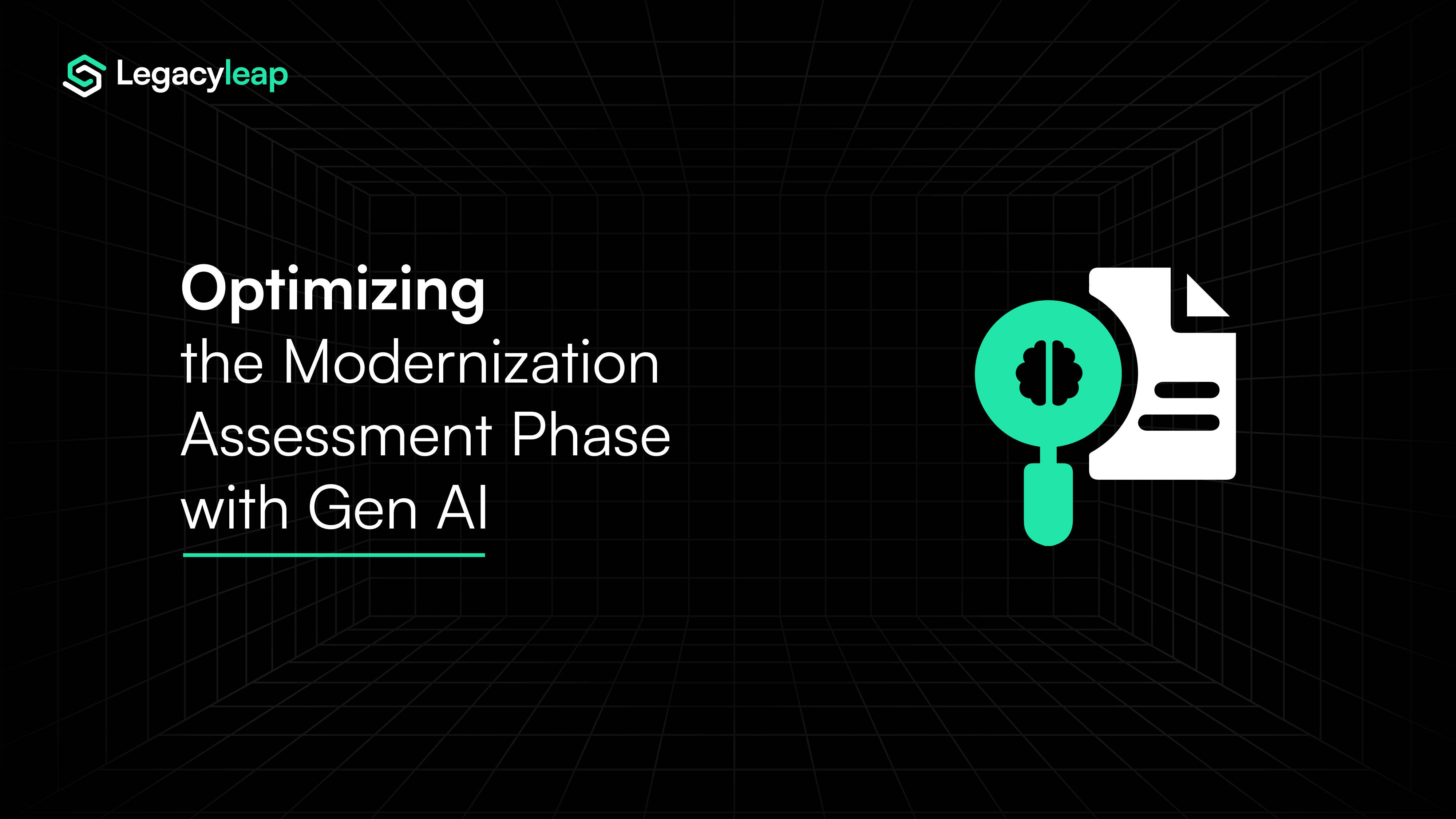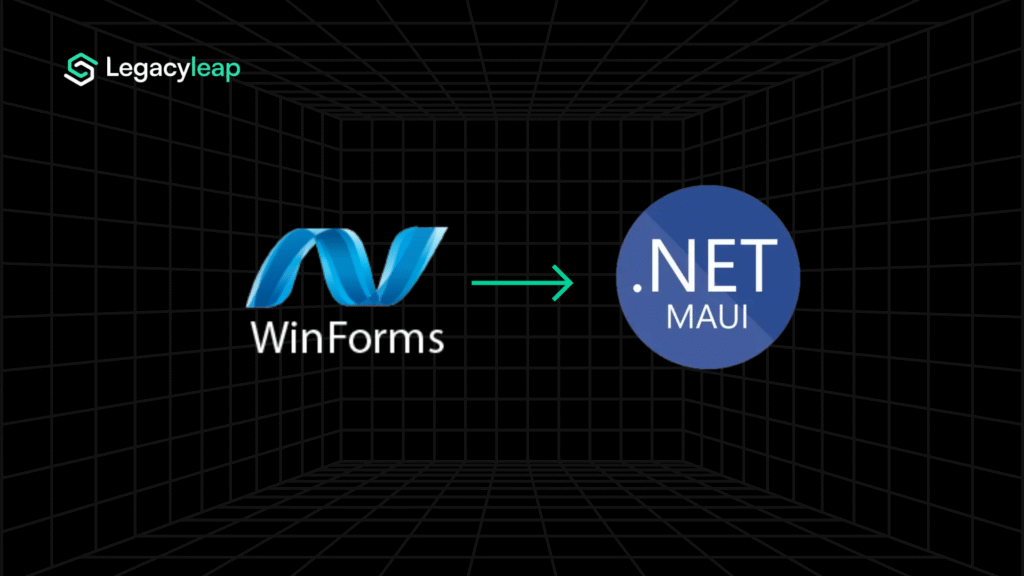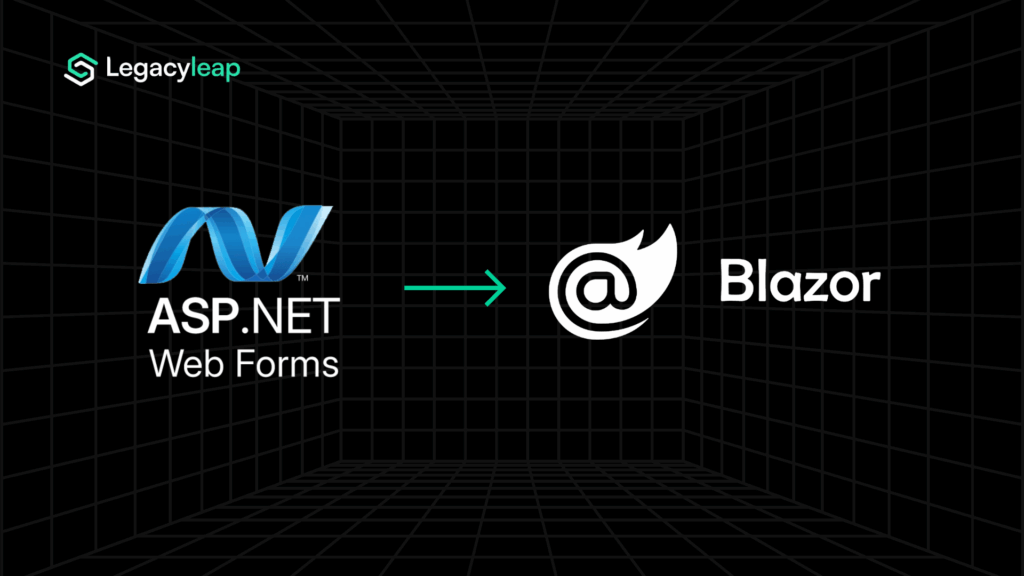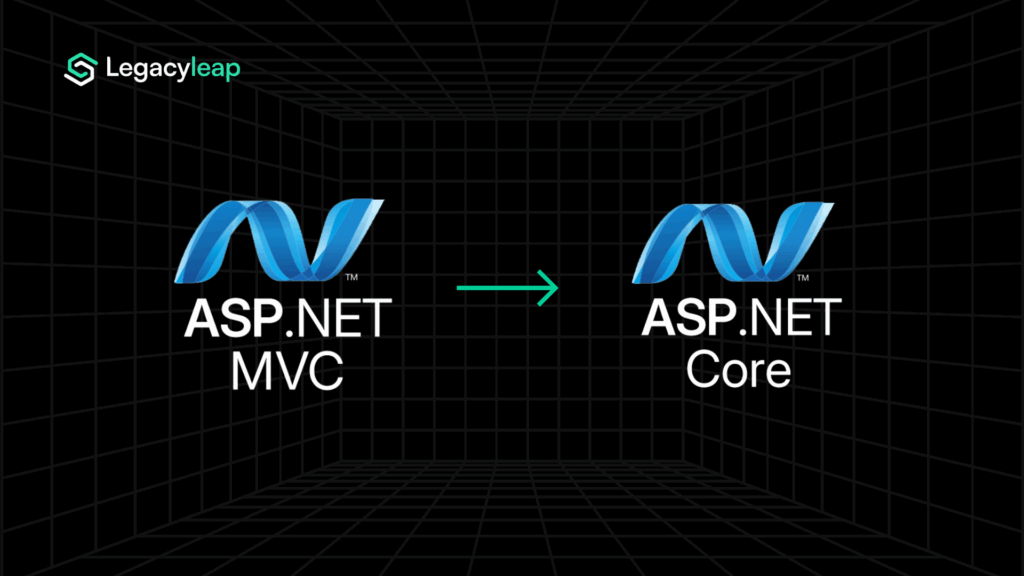The Assessment and Recommendation phase is the bedrock of any successful modernization journey. It’s where organizations map out the state of their legacy systems, identify bottlenecks, and evaluate opportunities for transformation.
Traditionally, this phase relies on manual processes, static analysis tools, and subjective evaluations—methods that often fall short in uncovering the true depth of system complexity or aligning recommendations with evolving business needs.
However, there is finally a way to automate and enhance key aspects of this stage with one missing element – Generative AI.
Gen AI introduces unprecedented accuracy, speed, and depth to the assessment process. It not only identifies technical debt and code inefficiencies but also aligns recommendations with business objectives, bridging the gap between technical and strategic goals.
In this blog, we’ll explore how the traditional assessment process works, the challenges it presents, and how you can leverage Gen AI to redefine modernization readiness. From generating detailed technical debt reports to recommending scalable architectures, Gen AI transforms assessment from a static step into a dynamic, actionable blueprint for modernization success.
If you’re looking to ensure your modernization journey progresses seamlessly, this stage—and the role of Gen AI in it—lays the groundwork for informed, actionable decisions.
Prefer to listen?
This episode of The Legacy2Leverage Show explores the topic in podcast form.
How the Traditional Assessment and Recommendation Process Works
In the traditional Assessment and Recommendation phase approach, organizations rely on a mix of manual evaluations and tool-based analyses. This process is designed to establish the current state of legacy systems, identify pain points, and propose actionable modernization strategies.
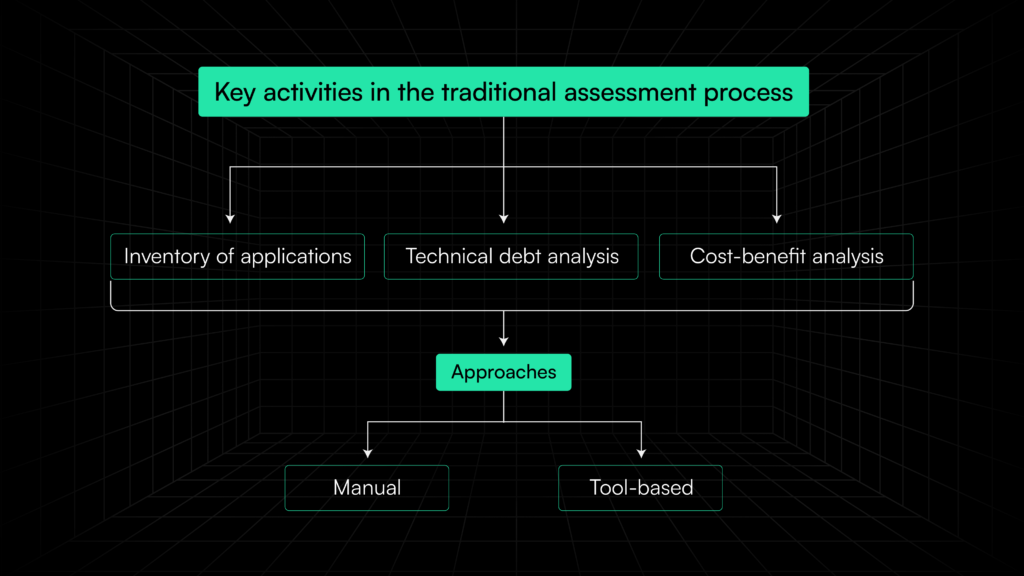
1. Inventory of applications
Creating a comprehensive catalog of legacy systems, capturing their functionalities, dependencies, and known performance bottlenecks. This step typically involves consulting technical documentation, conducting stakeholder interviews, and manual audits.
2. Technical debt analysis
Manually reviewing the codebase to evaluate its maintainability and uncover issues such as:
- Code complexity: Measuring cyclomatic complexity to assess readability and scalability.
- Security vulnerabilities: Identifying weak points that may compromise data or operations.
- Integration challenges: Highlighting compatibility issues with newer technologies.
Also check out: Technical Debt in Legacy Applications — explore how legacy systems accumulate technical debt and what it means for your modernization plan.
3. Cost-Benefit Analysis
Balancing the financial implications of maintaining existing systems against the projected benefits of modernization. This analysis often includes calculating operational inefficiencies, estimating migration costs, and predicting ROI for updated architectures.
Common Approaches
- Manual processes: Interviews, spreadsheets, and documentation reviews are used to create a snapshot of the system, but these can be time-intensive and prone to human error.
- Tool-based techniques: Static code analyzers, security scanners, and dependency mapping tools assist in automating parts of the evaluation but often work in silos, requiring additional effort to integrate findings.
While these methods have served as the foundation for modernization projects, they are often constrained by the overwhelming complexity of legacy systems and the siloed nature of their tools.
What Challenges Limit the Effectiveness of Traditional Assessment Methods
The traditional assessment and recommendation process often lacks the clarity and precision required for effective modernization. Below are the primary challenges:
1. Overwhelming complexity
Legacy ecosystems often consist of countless applications with intricate interdependencies. Understanding how these systems work together—or don’t—requires a significant investment of time and effort.
Without the right tools, this complexity can result in missed risks, overlooked opportunities, and inefficiencies that hinder progress.
2. Resistance to change
Modernization initiatives often face internal pushback. Employees may fear disruptions to their workflows or even job loss, leading to incomplete feedback and skewed data during the assessment phase. This resistance undermines the accuracy of recommendations, jeopardizing project outcomes.
3. Budget constraints
Conducting a thorough assessment can be expensive. Organizations working with tight budgets often limit the scope of evaluations, relying on superficial analyses that fail to account for deeper technical or business implications. This creates a foundation of suboptimal planning, increasing the risk of failure later in the project.
4. Business-technology misalignment
Legacy systems often struggle to keep up with evolving business needs. Traditional processes may identify technical debt but fail to link these findings to business goals, such as scalability, customer experience, or market competitiveness. This disconnect results in recommendations that lack actionable value.
These challenges underline the limitations of traditional approaches in delivering actionable insights for modernization. To overcome these barriers and lay a solid foundation for success, a more innovative and efficient approach that bridges gaps and aligns both technical and business objectives seamlessly is required.
Traditional vs Gen AI-Based Modernization Assessment
| Criteria | Traditional Assessment | Gen AI-Powered Assessment (Legacyleap) |
| Speed & Scale | Manual, takes weeks; struggles with large codebases | Completed in days; scales across 1000s of files and modules |
| Code Understanding | Shallow, based on surface-level static analysis | Deep analysis using compiler graphs + Gen AI summarization of business logic |
| Tooling Context | Disconnected scans across siloed tools | Unified model analyzing across code, APIs, data flows, UI layers |
| Dependency & Risk Mapping | Often missed or partial due to manual effort | Auto-generated graphs with runtime flow, data lineage, and API path mapping |
| Technical Debt Insight | Generic estimates or subjective scoring | Severity-ranked issues tied to impact on performance, cost, and scalability |
| Security & Compliance | External scans not integrated with architecture | Security risks and anti-patterns mapped inline with code and architecture |
| Business Traceability | Little to no visibility into how logic connects to business processes | UI-to-logic flow maps, Swagger docs, and natural language summaries for business teams |
| Modernization Readiness | Vague recommendations like “move to cloud” | Actionable strategies: rehost, refactor, rebuild—based on system-specific feasibility |
| Confidence to Proceed | Low; relies on assumptions or consultancy opinions | High; driven by code artifacts, system maps, and explainable AI outputs |
Checklist: How to Prepare for a Gen AI-Powered Modernization Assessment
Before implementing a Gen AI-led assessment, ensure the following foundational elements are in place:
Create an updated inventory of all legacy applications, systems, and environments.
Enable access to source code repositories or packaged application binaries.
Ensure availability of runtime logs, API call traces, and system performance metrics.
Define key business priorities (e.g., faster time to market, scalability, compliance).
Identify stakeholders across IT, operations, and business for alignment sessions.
Clarify current pain points in architecture, integrations, or user experience.
Assign a point-of-contact from both the development and infrastructure teams.
Confirm NDA, security, and compliance readiness before Gen AI engagement.
Schedule time for technical validation and stakeholder review of AI-generated outputs.
How Legacyleap’s Gen AI Framework Transforms Modernization Assessments
Modernizing legacy systems requires a balance between technical insight and strategic alignment. Gen AI offers unprecedented automation and intelligence to streamline this process, but its impact is amplified only when combined with human expertise.
By integrating Gen AI with human oversight and tailored solutions, Legacyleap ensures the assessment stage delivers actionable, business-aligned outcomes.
Streamlining inventory management
Legacyleap employs Gen AI models to automatically document applications, their interdependencies, and system performance metrics. This includes analyzing API calls, data flow diagrams, and runtime logs to create a real-time map of system behavior.
The automated inventory process identifies redundancies, underutilized components, and critical failure points, providing a foundation for informed modernization strategies.
Advanced technical debt analysis
By leveraging Gen AI-powered tools, Legacyleap performs both static and dynamic analysis of codebases.
Static analysis evaluates syntax and structural issues, including cognitive complexity, dead code, and potential bugs. Dynamic analysis runs real-time simulations to uncover performance bottlenecks, concurrency issues, and memory leaks.
The platform generates detailed technical debt reports, prioritizing issues based on severity and business impact. These insights are validated by developers who contextualize the findings within operational realities, ensuring actionable recommendations.
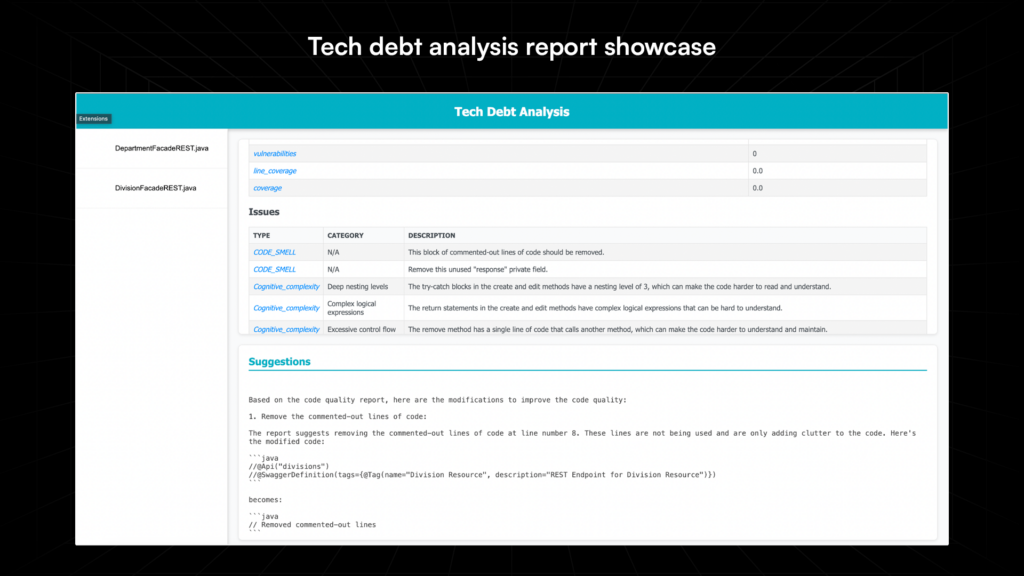
Microservices Recommendation
Legacyleap’s Gen AI framework is pioneering microservices transformation with its early-stage implementation tools. By analyzing monolithic applications, AI models evaluate the autonomy, coupling, and scalability of individual modules. These insights help define the boundaries of potential microservices, outlining how functionalities can be decoupled while maintaining system integrity.
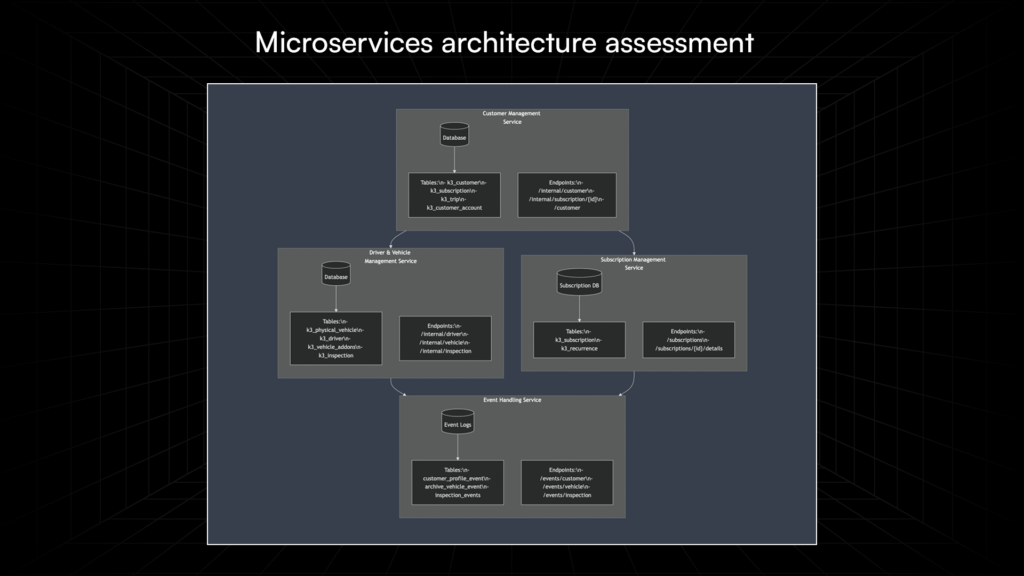
For instance, business-critical modules that exhibit frequent updates can be identified as candidates for standalone services, while legacy dependencies are flagged for phased refactoring.
The tool provides visual diagrams of the proposed microservices architecture, enabling teams to plan the transition effectively and iteratively.
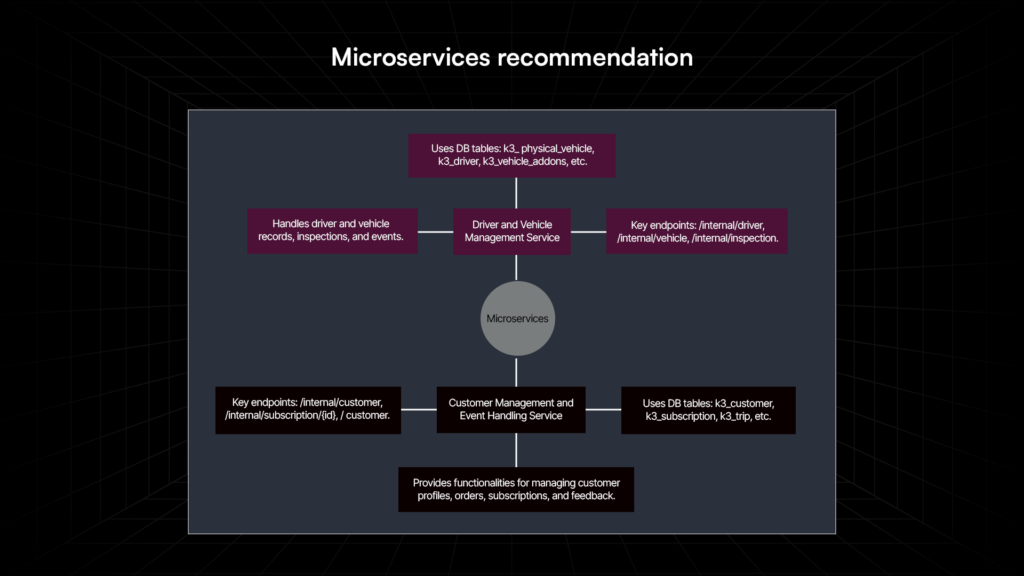
Intelligent business-technology alignment
Legacyleap’s Gen AI solutions analyze evolving business requirements, current market trends, and system usage patterns to recommend modern architectures. For example, AI models evaluate legacy systems to identify candidates for microservices, based on factors like module autonomy, frequency of change, and resource usage.
Additionally, serverless architecture recommendations are optimized for scalability and cost-effectiveness, tailoring solutions to the organization’s long-term goals.
Human-in-the-loop approach
While Gen AI delivers automation at scale, Legacyleap ensures human validation to bridge the gap between machine-generated insights and real-world applications. Developers work alongside Gen AI to refine recommendations, ensuring they align with business goals, compliance requirements, and operational constraints.
This collaborative model reduces implementation risks and improves stakeholder confidence in modernization strategies.
Dynamic report generation
Using advanced reporting frameworks, Legacyleap generates customized outputs based on Gen AI analysis.
For technical teams, reports include in-depth code quality assessments, vulnerability matrices, and system architecture diagrams. For business stakeholders, insights are translated into operational metrics like projected cost savings, time-to-market improvements, and ROI estimations.
These reports adapt to varying levels of access, accommodating situations where full codebase or infrastructure data isn’t available.
Scalable implementation
Legacyleap’s flexibility shines in its deployment models. Static code analysis options provide immediate insights for organizations seeking quick assessments, while agent-based evaluations delve deeper, analyzing runtime behaviors and integration points in live environments.
The platform scales from small pilot projects to enterprise-wide evaluations, adapting to the complexity and size of the modernization effort.
This combination of advanced Gen AI capabilities and expert oversight for tailored reporting and scalable solutions turns the assessment stage into a powerful enabler of modernization. Every insight is designed to deliver measurable value, ensuring your legacy systems evolve seamlessly into future-ready solutions.
How Gen AI Helps Establish a Stronger Foundation for Modernization Success
The assessment and recommendation stage is where technical insights, business priorities, and future objectives converge to shape a clear roadmap forward. Traditionally plagued by complexity, resource constraints, and alignment gaps, this stage has long demanded a more robust, intelligent approach.
With the advent of Gen AI, these challenges are now opportunities to elevate modernization strategies. With automated inventory management, refined technical debt analysis, and intelligent alignment of business needs with cutting-edge architectures like microservices and cloud-native designs, Gen AI delivers unmatched precision and actionable insights.
At Legacyleap, we take Gen AI a step further—blending its computational power with developer expertise to ensure every recommendation is not only accurate but also practical and business-aligned, turning the modernization journey into a value-driven process.
Ready to explore how Gen AI can redefine your modernization roadmap? Check out our website to learn more!
And if you’re interested to learn more about how Gen AI can change the way you approach modernization as a whole, here’s a detailed guide for you: How Can Gen AI Drive Every Step of Your Modernization Journey?
FAQs
Partial access is possible, but full code access dramatically improves the accuracy and value of a Gen AI assessment. Legacyleap can still provide directional insights with limited inputs (e.g., binaries, runtime logs, API contracts), but for deep dependency mapping, technical debt scoring, and modernization pathing, ingesting the actual source code is critical.
You get both insights and actionables. Legacyleap’s assessment delivers architecture maps, UI-to-logic flow diagrams, transformation feasibility scores, and Swagger documentation, ready to use in your modernization plan. Every AI-generated output is traceable, validated by SMEs, and tailored to your system.
Legacyleap uses Gen AI in combination with graph-based system models to infer business logic, even from tightly coupled or non-standard code. It generates natural-language summaries, identifies critical flows, and aligns findings with business goals defined during stakeholder sessions, ensuring assessments reflect your actual operational realities.
Legacyleap assessments are conducted entirely within your secure environment. No source code or data leaves your infrastructure. The platform supports audit logs, role-based access, and model context restrictions. This ensures compliance with regulations like HIPAA, SOC 2, and internal governance standards from day one.
Post-assessment, your team gets a detailed walkthrough of all outputs with our experts, technical and business. You also receive structured next steps, modernization options tailored to your goals, and the option to move directly into execution with Legacyleap’s Gen AI-powered refactoring engine. Think of it as a handoff plus a roadmap.

